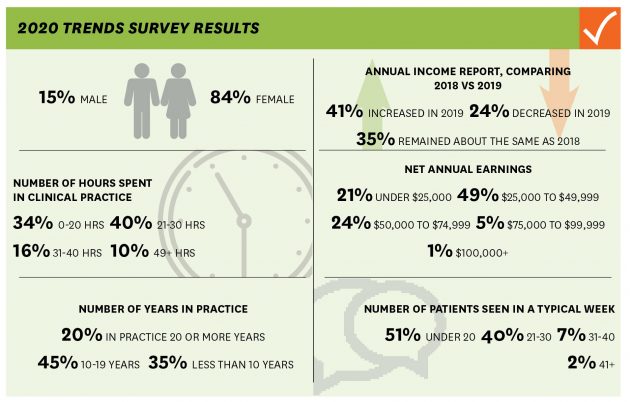
Features
Practice
Patient Care
Research
On the trend: Results from our 1st annual Practice Trends Survey
January 26, 2021 By MTC STAFF
 Photo: © ty / Adobe Stock
Photo: © ty / Adobe Stock Although we should not extrapolate the following survey results from the 182 responses Massage Therapy Canada obtained to entirety of the profession, survey results like these can help facilitate discussion, moving the massage therapy profession froward.
The majority of our respondents were from Ontario (29%), followed by Mantioba (23%), Saskatchewan (15%), and Alberta (13%).
Case management and earnings
This year, the majority of respondents (44%) reported they have been in practice for 10-19 years, 20% of respondents have been in practice for 20+ years, and those who practised less than 10 years hovered at 35%.
Working in a multidisciplinary clinic with complementary health care providers (chiropractor, naturopath, etc.) and no MDs, was the top choice for RMTs in Canada, accounting for 29% of responses. A solo practice, at home was the next selection (26%), followed by solo practice, in a rented space (18%). Next year, we expect to add a few more choices based on our “other” responses. For instance, it’s likely we will see mobile practices expand within the next year, due to the pandemic and subsequent after effects.
Massage therapists who have been practising for 20+ years reported spending less than 30 hours per week on clinical practice (70%) and saw less than 20 patients per week (59%). Whereas with the group practising for under 20 years, 48% reported seeing under 20 patients per week 43% reported seeing between 21-30 patients, 6% saw 31-40 and 2% saw 41-100 patients. For those practising less than 20 years, this was the only group who listed seeing between 41-100 patients per week. The younger age cohort was also more likely to spend more time in clincial practice, with 12% spending 41+ hours per week vs 5% of those practising for more than 20 years. Our “under 20s” were also more likely to work in a multidicisplinary practice, while our “over 20s” were more likely to practice solo, at-home.
The majority of over 20s (again, years in practice, not age) reported their net annual earnings in 2019 – after taxes and expenses – to be between $26,000-$50,000 (51%), 30% selected between $51,000-75,000, and 14% earned under $25,000.
Our under 20s were on par as well, with the majority of them (48%) selecting the same income level ($26,000-$50,000). The under 20 group were tied when it came to income levels below $25,000 and $51,000-$75,000 (23%).
The majority of RMTs in general do not earn supplemental income, but of those who do, rental income accounted for 12% of responses.

Icons: Freepik / Flaticon.com
Scope of practice, loss of income, biggest challenges
Despite the survey taking place in the latter half of 2020, the income statements/numbers we ask for are always from the previous tax year. Due to the COVID-19 pandemic, we asked our readership: “Do you expect to see/have you seen a marked decrease in income/earnings for 2020 due to the COVID-19 pandemic? (All answers are in NET earnings).”
Your answers: 59% expect a loss of income of $10,000 or more compared to 2019; 23% expect a loss of income of around $20,000 or more; 7% expect a loss of income of around $30,000+. There are some who expect their income to remain the same and they will suffer no income loss – 12% are confident in this.
More than likely due to these figures, the majority of RMTs (61%) are not expecting to splurge on any major purchases within the next 12 months, with the exception being that 20% of therapists are planning to purchase office furniture, computers or other administrative tech, and/or conduct renovations. Again, this could be due to the pandemic and major business/scheduling/administrative changes clinic and business owners are enacting.
It’s very clear that RMTs across the country are experiencing very vast challenges. When the question “What is your biggest challenge you face in your profession?” was posed, 32% selected “other.” COVID-19 was one of the obvious responses, followed by, essentially lack of regulation.
The pandemic could also be an indicator of why 16% chose the “high cost of running their practice” as their selection. Following closely behind was “a lack of – or not enough – inter-professional collaboration (15%). Both “oversaturated market/low-utilization rate” and “lack of support by national/provincial associations, or my regulatory college” were tied at 11%.
An overwhelming majority of RMTs were supportive of changing the scope of practice, depending on what the research tells us (68%), 14% were indifferent, while 13% said there was no need to change anything.
The COVID-19 pandemic has sent waves of worry and frustration this year across the country. But once we are out of the other side of this, there are still essential issues the profession needs to deal with. From one RMT: “After 16 years of having to break down doors to get a little respect. I’m fed up. I’m done.”
As a profession we have many challenges we need to focus on and face – even if it’s uncomfortable. let’s focus on where we need to go.
Print this page